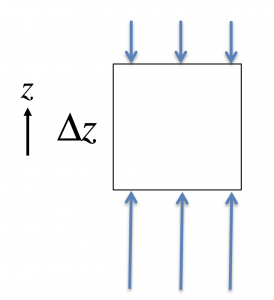20 Hydrostatic balance

We know from experience that pressure increases with depth in the ocean, but why? Consider a water parcel (an infinitesimal control volume) in the ocean interior. Because pressure is increasing with depth, there will be a greater total force on the lower surface than on the upper surface, associated with a net upward PGF.
Why don’t water parcels accelerate upward in response to the PGF? In the ocean there is a steady-state balance between the vertical component of the PGF and the downward-directed gravitational acceleration (![]() , the gravitational force per unit mass) that keeps water parcels in the ocean close to a state of zero vertical acceleration.
, the gravitational force per unit mass) that keeps water parcels in the ocean close to a state of zero vertical acceleration.
This balance can be written, with the acceleration (0) on the left, and forces on the right:
![]()
![]()
We can thus calculate the vertical pressure gradient
![]()
Since the right side is always a negative number, pressure decreases as we move upwards (to greater values of z) within the ocean.
By integrating this expression from some depth below the resting ocean surface, ![]() , to the sea surface,
, to the sea surface, ![]() , we can find the hydrostatic pressure at depth
, we can find the hydrostatic pressure at depth ![]() .
.
![]()
Oceanographers commonly use a convention that the atmospheric pressure ![]() , thereby wrapping the standard atmosphere into the background state. The pressure at depth
, thereby wrapping the standard atmosphere into the background state. The pressure at depth ![]() (where
(where ![]() ) becomes
) becomes
![]()
If you are not yet familiar with integration, you can instead think of a finite difference representation of the gradient over a small distance,
![]()
and you will end up with the same expression when you solve for ![]()
Key Takeaways
Hydrostatic Balance is the state where the gravitational acceleration balances the vertical component of the pressure gradient force.
In a resting fluid with the sea surface at z = 0, the value of the hydrostatic pressure at depth ![]() (where
(where ![]() ) is
) is
![]()
The hydrostatic pressure gradient has only a vertical component, equal to
![]()
Note: In general, if the ocean is not at rest, then its surface may not be located at ![]() . You would still use the depth below the ocean surface,
. You would still use the depth below the ocean surface, ![]() , but the z-coordinate at that depth may vary.
, but the z-coordinate at that depth may vary.
Mini-lecture for class:
Media Attributions
- PGFz © Susan Hautala is licensed under a CC BY-NC-SA (Attribution NonCommercial ShareAlike) license

